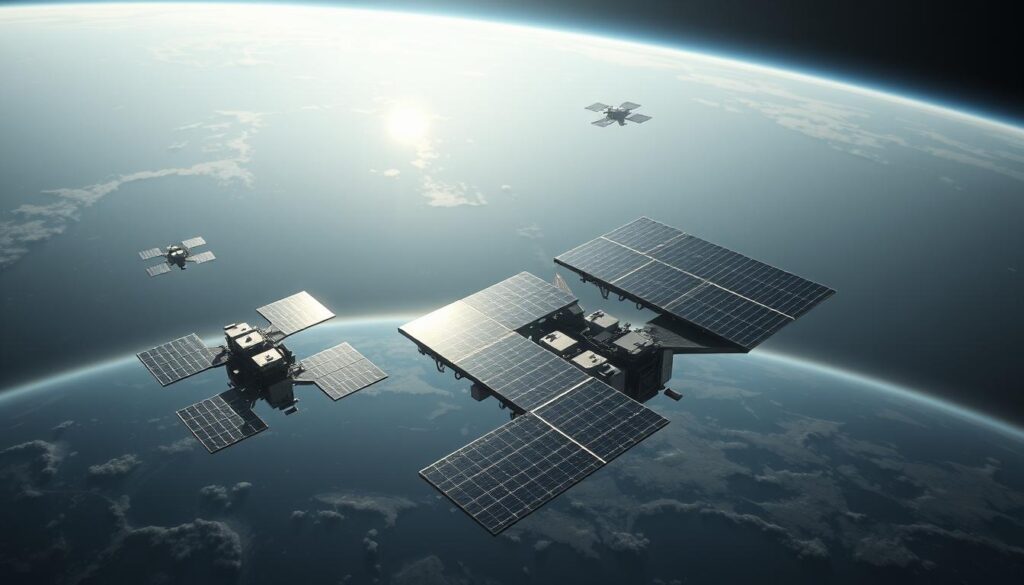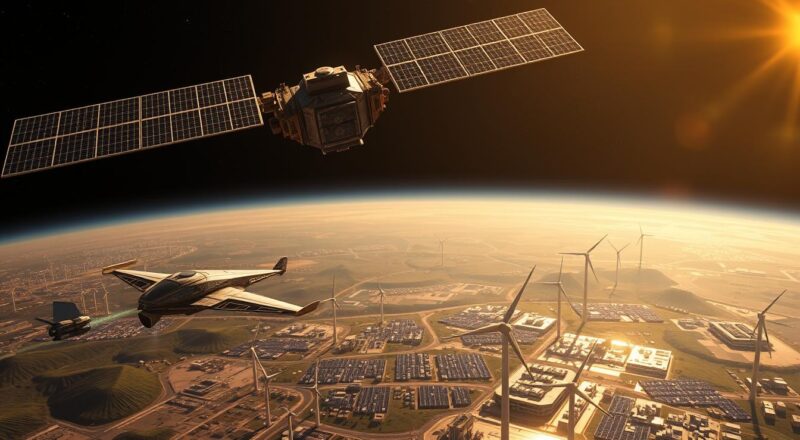Space is the new frontier for harvesting solar energy, pushing the boundaries of conventional power generation. Using cutting-edge space technology, we can collect solar energy without Earth’s atmospheric limits or the cycle of day and night. This breakthrough marks the dawn of a new age where clean, constant, and efficient energy can fulfill our growing energy needs.
Turning the dream of endless solar power from space into reality is now closer than we think. As we pour money into space advancements and refine our solar technologies, a revolution in power is at our doorstep. This unlimited solar potential could greatly support our quest for energy freedom and help us fight against climate change.
As we move forward with space technologies, our journey toward significant energy discoveries continues. Our efforts to harness solar energy from space show our creativity and commitment to a better, greener future. This step in space innovation is set to change the story of renewable energy for our world.
- Key Takeaways
- A New Dawn: The Concept of Space-Based Solar Power
- Challenges and Innovations in Orbital Solar Power Platforms
- The Role of Satellite Solar Panels in Renewable Energy
- Global Initiatives and Investments in Space Solar Technology
- Benefits of Space Solar Power for Sustainable Energy
- Comparative Analysis: Space-Based Solar vs. Earth-Based Solar Energy
- Overcoming the Barriers: Accessibility and Deployment of Space-Based Energy Solutions
- Future Projections: The Potential Impact of Orbital Solar Power on Global Energy Markets
- Case Studies: Successful Deployments of Space Solar Energy
- Conclusion
- Outbound Links
- FAQ
- What exactly is space-based solar power?
- How do space solar arrays differ from terrestrial solar panels?
- What are the main technical challenges facing the implementation of orbital solar power platforms?
- What innovations are propelling the development of solar panel and energy transmission technologies?
- Which countries and companies are currently leading in space solar research and development?
- What are the benefits of utilizing space solar power over traditional renewable energy sources?
- How might space solar power contribute to global energy accessibility?
- What impact is orbital solar power expected to have on global energy markets in the future?
- How successful have past deployments of space-based solar energy been?
Key Takeaways
- Space-based solar power represents an innovative shift in harvesting solar energy, free from terrestrial barriers.
- Utilizing space technology for energy generation promises an uninterrupted solar power supply to Earth.
- The feasibility of capturing solar energy from space is bolstered by a surge in space innovation and global investments.
- This paradigm shift in renewable energy in space can play a pivotal role in achieving our sustainable energy ambitions.
- As solar power solutions advance, space-based energy systems edge closer to becoming a staple in our energy grid.
A New Dawn: The Concept of Space-Based Solar Power
Exploring space solar arrays opens a new chapter in renewable energy. These advancements in solar power satellites and orbital platforms are set to change how we generate energy. Space-based solar energy offers a way to capture sunlight with unmatched efficiency. By placing solar panels in orbit, they avoid atmospheric interference and the day-night cycle. This means a constant and intense stream of energy can come directly to Earth.

Understanding the Basics of Space Solar Arrays
Space solar arrays are huge fields of photovoltaic panels in space. They sit in a place where they can consistently catch more sunlight than panels on Earth. This ability could forever change renewable energy by providing a steady and reliable power source.
The Historical Journey: From Idea to Near Reality
The idea of using space for solar power has moved from just a fantasy to almost real. Thanks to advances in aerospace and solar tech, the concept of solar power satellites has grown. Now, what was once a dream could soon become a practical way to use solar energy.
Challenges and Innovations in Orbital Solar Power Platforms
The journey to use solar power in space is filled with challenges and new discoveries. The idea of getting power from space is exciting. But, we need to solve tough problems and invent new technology for solar panels and how we send energy to Earth.
Technical Hurdles in Harnessing Space Solar Energy
Creating solar panels for space is challenging. They must handle space’s harsh conditions, like radiation and big temperature changes. Also, sending power wirelessly from space to Earth is tricky. It must be done with great care and efficiency.
Breakthroughs in Solar Panel and Transmission Technologies
Space technology has led to creating super thin and efficient perovskite solar panels. Aetherflux, a project by Baiju Bhatt, is making big moves. They plan to use infrared technology to send energy with minimal loss. This shows a big step in how we can get and share solar power from space.
| Technology | Description | Impact |
|---|---|---|
| Perovskite Solar Panels | Ultra-thin, lightweight panels with superior efficiency | Boosts potential energy yield in space conditions |
| Infrared Transmission | Wireless energy transmission using infrared lasers | Reduces energy loss during transmission from satellite to Earth |

The Role of Satellite Solar Panels in Renewable Energy
Satellite solar panels play a vital role in space renewable energy. They are not just advanced; they lead a major shift in solar power. The operation in space increases their efficiency, making them top in innovation.

Space solar panels outperform earth ones due to no atmosphere or weather. They capture more sunlight, pushing efficiency beyond earth’s reach. This shows human creativity and points us towards a renewable energy future in space.
| Characteristic | Terrestrial Solar Panels | Satellite Solar Panels |
|---|---|---|
| Exposure to Sunlight | Limited by day/night cycle and weather | Continuous exposure without interruptions |
| Efficiency Rate | Approximately 15-22% | Up to 8 times higher than terrestrial |
| Operational Lifespan | Often affected by environmental factors | Longer due to lack of atmospheric degradation |
| Initial Cost and ROI | Lower initial cost, variable ROI dependent on location | Higher initial cost, consistently higher ROI due to efficiency |
Using satellite solar panels for space solar power is a big step for sustainability. These panels offer stable power, unlike terrestrial options. Through them, we’re not just exploring science but also securing future clean energy.
Global Initiatives and Investments in Space Solar Technology
In our time, renewable energy is key to lasting development. Many global efforts and smart investments are changing how we view space solar technology. Countries and businesses everywhere see the huge promise in getting energy from space. They are using their resources to embrace this new power source.
There’s a strong teamwork between government funding for green energy and the private space sector. Both are crucial in moving forward space solar technology. They help make the dream of solar power systems in orbit a reality.

Leading Countries and Companies in Space Solar Research
Japan and Saudi Arabia are at the forefront of space solar research. Japan has put over $1.5 billion into developing better solar cells. These new cells are more efficient and might change how solar panels are made. Saudi Arabia works with Spain and the U.S. to advance space energy. They’re doing groundbreaking work with solar parks and new solar systems.
Government and Private Sector Funding Trends
There’s a powerful connection between government vision and private creativity in funding and partnerships. Sekisui Chemical, known for its chemicals, is diving into space solar with investments in thin solar panels. Governments are also putting a lot of money into research. They want to help stop climate change and improve energy security.
The growth in this field points to a future with less reliance on fossil fuels. It shows a move towards more dependable renewable energy. Watching and supporting these advances highlights the role of space solar power. It could help create a world that’s both sustainable and has secure energy.
Benefits of Space Solar Power for Sustainable Energy
Space solar power is leading the way in innovative energy solutions. It holds the key to changing how we use renewable resources. We are nearing a major leap in sustainable energy thanks to it.
Advantages Over Traditional Renewable Energy Sources
Space solar power offers energy all day, unlike ground-based solar or wind energy. It isn’t stopped by bad weather or nightfall. With non-stop solar energy, we can have a steady and secure power supply. This will lessen our need for fossil fuels and boost energy security.
- Higher energy absorption due to the lack of atmospheric interference
- No land usage or terrestrial environmental impact, preserving natural habitats
- Potential integration with existing infrastructures to enhance power supply
Reduction in Carbon Footprint and Environmental Impact
Using space solar power can cut down our global carbon footprint. It uses the sun’s vast energy cleanly, avoiding the harm of earth-based energy methods. This change fights climate change and supports worldwide sustainability goals. It’s a big step for the environmental benefits of renewable energy.
- Decreased greenhouse gas emissions from fossil fuels
- Reduced air and water pollution compared to conventional power plants
- Minimization of ecological disruption and conservation of biodiversity

Space solar power is transforming renewable energy technologies. It’s not just about a green future; it’s about leading with care for our environment and being energy independent. Bringing space solar technologies into our energy systems is essential for progress in the years ahead.
Comparative Analysis: Space-Based Solar vs. Earth-Based Solar Energy
In the quest for renewable energy, knowing the difference between space-based solar power and terrestrial solar power is key. Space-based solar power comes from satellites in orbit. It gets constant sunlight, free from Earth’s weather and day/night changes. Earth-based solar power, though, deals with changing weather and daylight hours, affecting its output.
| Feature | Space-Based Solar Power | Terrestrial Solar Power |
|---|---|---|
| Energy Generation | Continuous throughout the day and night | Limited to daylight hours |
| Impact of Weather | Minimal | High |
| Installation Cost | Higher initial investment | Relatively lower cost |
| Scalability | Highly scalable on a global scale | Limited by geographical and physical constraints |
The comparative analysis of solar energy shows us how solar energy from space might change our approach to clean energy. But, there are big challenges in tech and cost that slow its use. Over time, with better tech and lower costs, space-based solar could really help our energy needs. This comparison not only shows each system’s benefits but also why we need more research and development in both to have a truly sustainable energy future.
Read more: Smarter Days: Free AI Tools to Simplify Daily Life
Read more: How to Use AI Tools to Save Time Daily
Read more: Remote Ready: Essential Tools for New Work-from-Home Jobs
Overcoming the Barriers: Accessibility and Deployment of Space-Based Energy Solutions
The journey to find clean, endless energy takes us to space. Here, overcoming barriers in renewable energy is key. At the heart of this mission is the deployment of solar power satellites, a plan that could change how we get and share energy worldwide.
To make space energy accessible, we need new ideas. The big costs of starting and building the necessary infrastructure are major hurdles. We need to work together worldwide and use the latest aerospace technology to make it cheaper. This way, solar power from space becomes a real choice for many places.
Also, we face big challenges in creating and taking care of solar power satellites. Advancements in materials science and robots are vital. They will help us look after the satellites better and keep power flowing. Overcoming these technical and cost barriers is essential for renewable energy to grow.
These efforts aim to bring clean energy to all and build a sustainable future. By focusing on these goals, we are planning for an energy future that will help not only us but also many generations to come all over the world.
Future Projections: The Potential Impact of Orbital Solar Power on Global Energy Markets
The rise of future of orbital solar power is set to change global energy markets deeply. With space-based renewable energy, we’re not just seeing a new tech trend. It’s a major shift that could change how we get energy. This article looks at how these improvements could make people use more renewable energy across the world.
Experts in energy say that orbital solar power could hugely increase renewable energy use. This growth could change energy policies and rules, leading to stronger support for renewable energy everywhere.
Next, we dive into the expected tech upgrades and policy changes that could boost the renewable energy field:
| Year | Technological Advancements | Policy Enhancements | Adoption Rate |
|---|---|---|---|
| 2025 | Commercial deployment of the first orbital solar arrays | Introduction of global tariffs on non-renewable energy | 5% increase |
| 2030 | Breakthroughs in wireless energy transmission efficiency | Standardization of space-based solar power regulations | 10% increase |
| 2035 | Reduction in costs of orbital solar installations | Implementation of compulsory renewable energy adoption in urban planning | 15% increase |
The table above shows a hopeful path for space-based renewable energy in improving global energy markets. These steps are likely to push for more use of space-based renewable energy. This would be a big move towards cleaner and more reliable energy sources worldwide.
Case Studies: Successful Deployments of Space Solar Energy
Space-based energy solutions have made big strides recently. Several successful solar power deployments show their growth. These projects prove that technology for space solar energy works and can grow in different places.
One key project set up a big solar panel array on an international space station. It powered the station and gave important data on how solar cells work in space. This data helps us find the best materials and designs.
In places hit by disasters, where normal power systems failed, portable solar power from space came to the rescue. It gave energy to help emergency responses and recovery efforts. This shows how adaptable and crucial solar power is.
| Project | Description | Impact |
|---|---|---|
| Space Station Solar Arrays | Installation of high-efficiency solar panels on an international space station. | Continuous power supply to the station, enhanced understanding of solar technologies in space. |
| Emergency Solar Power Kits | Deployment of portable solar power units in disaster-stricken areas. | Provided critical power support during crisis, demonstrated scalability and versatility of solar power. |
These examples tell us that space solar energy is more than just theory. They are building a solid foundation for the future. Solar energy from space is playing a big part in making our power systems better and opening new ways to generate power.
Conclusion
Throughout this article, we’ve seen how space-based solar power could change renewable energy forever. By using solar energy from space, we get way more power than we could on Earth. This isn’t just a dream. It’s quickly becoming a real solution for clean, never-ending energy around the world. The idea of getting solar energy from space and sending it to Earth is at the heart of space innovation. It opens new doors for living in harmony with our planet.
The progress in space-based solar power shows our need to find new energy sources and fight climate change. This method is more efficient and kinder to our planet. It proves our dedication to a future where clean energy is easy for everyone to get. This isn’t just imagination at work—it’s a practical step using what we know to make a better energy future.
Exploring space-based solar power shows we care about the future. By accepting this technology, we make sure the renewable energy revolution lasts. It won’t be just a brief trend, but a lasting effort for a brighter, stronger future. As we keep exploring new possibilities, we’re excited to see how these space projects will make our world more sustainable.
Outbound Links
FAQ
What exactly is space-based solar power?
Space-based solar power collects sun energy using panels in space. These panels get sunlight directly, turn it into electricity, and send it back to Earth. This gives us a non-stop and effective power supply.
How do space solar arrays differ from terrestrial solar panels?
Space solar arrays sit in orbit. They grab sunlight directly without atmospheric blockage. They work all the time, avoiding issues like night or bad weather. That’s why they’re much more efficient than Earth’s solar panels.
What are the main technical challenges facing the implementation of orbital solar power platforms?
The big challenges are finding good ways to send energy to Earth and building panels that can handle space. We also need to look at the high costs and make sure the technology is safe and reliable.
What innovations are propelling the development of solar panel and energy transmission technologies?
The push forward includes making solar panels from special materials like perovskites. There’s also progress in sending power wirelessly, using things like lasers and microwaves, to get energy from space to Earth safely.
Which countries and companies are currently leading in space solar research and development?
Japan and Saudi Arabia are at the front, with Japan focusing on perovskite technology. Companies like Sekisui Chemical and Aetherflux are doing great work in space energy solutions.
What are the benefits of utilizing space solar power over traditional renewable energy sources?
Space solar power is better because it gets direct sunlight, works all the time, and doesn’t need a lot of land. This means less carbon pollution and less harm to the environment.
How might space solar power contribute to global energy accessibility?
Space solar power could help power remote places by using small, spread-out receptors. This means clean, renewable energy could reach more parts of the world.
What impact is orbital solar power expected to have on global energy markets in the future?
As the tech gets better and cheaper, space solar power could really take off. This might change energy policies and lead to more renewable energy use. It would make clean power easier to get everywhere.
How successful have past deployments of space-based solar energy been?
While we’re still starting, tests and projects have shown that space solar power works. Experiments with satellites and ground tests have shown what can be done, helping us move towards sustainable energy.
Get in Touch with SJ Articles
Read more: Learn a New Skill Fast with These Bite-Sized Courses
Read more: Automated Machine Learning Guide 2025
Read more: Microlearning for Career Growth in 2025


